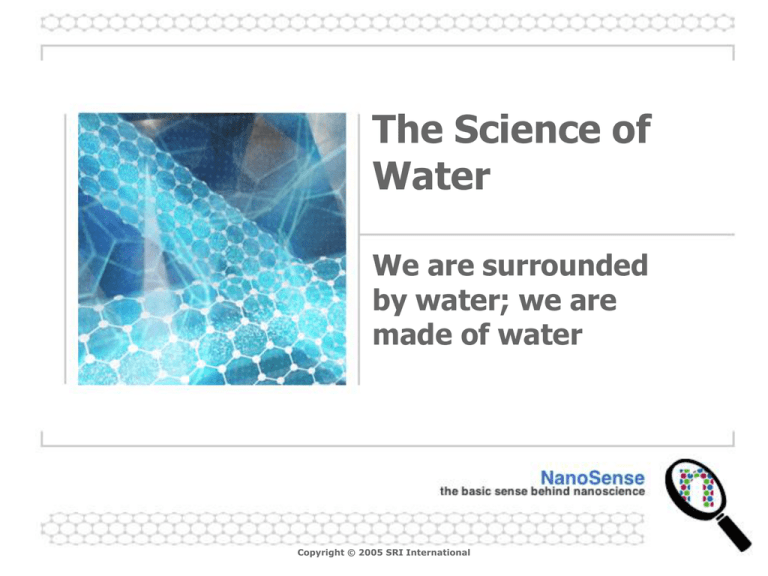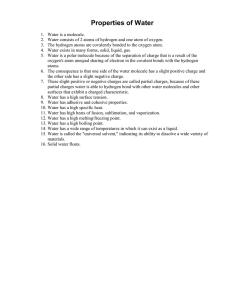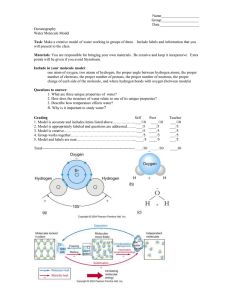The Science of Water We are surrounded by water; we are
advertisement

The Science of Water We are surrounded by water; we are made of water Copyright © 2005 SRI International 2 Water in our World • Water is necessary for life • Water in our atmosphere helps to keep the planet warm • Our bodies are composed of and dependent on water Source: http://nssdc.gsfc.nasa.gov/photo_gallery/photogallery-earth.html 3 A Quick Overview Of some of the science basics What are some of the properties of water that make it so essential to life on our planet? 4 All Matter is Composed of Atoms • The atom is composed of – A nucleus made of neutrons and protons – An electron “cloud” composed of electrons + proton neutron neutron + neutron Representation of a nucleus • Protons and neutrons have nearly identical masses, but their charge is different – Protons have a positive (+) electrical charge and neutrons do not have an electrical charge 5 Subatomic Particles Composing the Atom Subatomic Particle Charge Size Location Proton +1 1 Part of the nucleus Neutron 0 1 Part of the nucleus 0 Electron “cloud” (outside of the nucleus) Electron -1 6 The Quantum Atom • We can only describe areas of probability where we might find an electron – Electrons are constantly moving – Electrons have a specific amount (quantum) of energy, related to their position from the nucleus Source: http://physics.usc.edu/~bars/135/LectureNotes/QuantumMechanics.htm 1 Angstrom Red dots represent areas of probability 7 Probability • Suppose you had a new dartboard. What would it look like after you had played darts with it for six months? – Can you predict accurately where the next dart you throw will go? – Can you predict an area where the next dart is likely to go? Source: www.amisane.org/images/dartboard2.jpg 8 Question Why do we care about what atoms are made of? 9 Electric Charge • Electric charge is a basic force that causes movement - - + + Like charges repel - + Unlike charges attract 10 Net Charge of an Atom or Ion • The charge on any substance is a result of the total number (#) of – Protons (p) + charges, in the nucleus, and – Electrons (e-) - charges, outside the nucleus • If the # of…. – p = e– p > e– e- > p then the net charge is…. neutral (atom) positive (ion) negative (ion) 11 Atoms Bond • The outer electrons of both atoms are mutually attracted to the nuclei – Oppositely charged particles form a bond, representing a lower energy state for each of the atoms, releasing energy Source: ibchem.com/IB/ibfiles/ bonding/bon_img/cov3.gif Nature always wants to be in the lowest energy state! 12 Why are Bonds Formed? Bonds are formed because of the electrostatic attraction between atoms. In doing so, the atoms achieve a lower energy state. 13 Ionic Bond: Chlorine (Blue) Grabs Electron from Sodium (Red) Click the image above to view the animation in your web browser, or go to http://nanosense.org/download/finefilters/Nacl_SD.mov Source: http://visservices.sdsc.edu/projects/discovery/Nacl_SD.mov 14 Forming a Water Molecule • Unequal attraction to bonding electrons – Oxygen is a strong electron grabber (high electronegativity) – Hydrogen’s electron cloud tends to hang out close to oxygen, leaving H’s positively charged nucleus all by itself Orbital representations of hydrogen and oxygen + – – + A water molecule 15 Electron Density is Uneven • The average electron density around the oxygen atom in a water molecule is about 10 times greater than the density around the hydrogen atoms – This non-uniform distribution of positive and negative charges, called a A water molecule, with dipole, leads to the electron density represented by the shaded blue areas substance’s unusual behavior Source: http://www.llnl.gov/str/October05/Mundy.html 16 Water is a Polar Molecule • The unequal distribution of charges on the water molecule make it a polar molecule – One end is more negative, and one end is more positive More positive ends More negative end A water molecule - means partial negative charge + means partial positive charge 17 Hydrogen Bonding I • The partial negative end of the oxygen atom is attracted to the partial positive end of the H atom on an adjacent molecule • Hydrogen bonds give water its unique properties Hydrogen bonding between water molecules Source: http://www.biology.arizona.edu/biochemistry/tutorials/chemistry/page3.html 18 Hydrogen Bonding II Click the image above to view the animation in your web browser, or go to http://www.northland.cc.mn.us/biology/Biology1111/animations/hydrogenbonds.html 19 Hydrogen Bonding Representation • In water, hydrogen bonds form between the partially negatively charged oxygen atom and the partially positively charged hydrogen atom Source: www.personal.psu.edu/.../ bonddiagram.gif Water molecules, with the hydrogen bonds represented by the dotted lines 20 Unique Properties of Water • • • • • • Universal solvent Exists in nature as a solid, liquid, and gas The density of ice is less than liquid water High surface tension High heat capacity Exists as a liquid at room temperature 21 High Surface Tension • Allows water to form drops • Allows water to form waves • Water drops can “adhere” to surfaces even though gravity is pulling on them Source: Photo 2004 Edward Tsang 22 Can You Explain Why this Drop Sticks to the Leaf and Grows Larger? Source: http://www.azeemazeez.com/photos/wallpaper/water800.jpg 23 Or How this Spider Can Walk on Water? Source: http://static.flickr.com/82/237875014_4d579d57c5.jpg 24 Adhesion • Adhesive forces are attractive forces that occur between two unlike substances • In a narrow glass tube – Water molecules are more strongly attracted to the tube than they are to each other (cohesion) – The cup shape formed at the top of the water is called a meniscus Source: http://www.wtamu.edu/~crobinson/SoilWater/meniscus2.jpg 25 Water Climbs Trees! • Evapotranspiration – The tiny tubes in the root hairs suck up water from the soil – Inside the plant are more hollow tubes (xylem) for transporting water through the plant – Finally, water exits the plant through the tiny openings in its leaves (stomata) Source: Adapted from http://www.ualr.edu/botany/transpiration2.gif 26 High Specific Heat Keeps Beaches Cooler in the Day and Warmer at Night! • Specific heat – The amount of energy required to change 1 gram of a substance 1 oC • Water has high specific heat – Absorbs large amounts of heat energy before it begins to get hot – Releases heat energy slowly – Moderates the Earth's climate and helps living organisms regulate their body temperature Source: http://www.exodus.co.uk/pictures/d03hp120c.jpg 27 Solid, Liquid, and Gas • Water is the only substance which exists under normal conditions on earth as a solid, a liquid, and a gas Source: http://www.eskimo.com/~captain/slidesho/Lake_Twenty_Two_Partly_Frozen_Over_and_Snow_Covered.jpg 28 Ice is Less Dense than Water I Density of H2O at different temperatures Temperature oC Density g/cm3 0 (solid) 0.9150 0 (liquid) 0.9999 4 1.0000 20 0.9982 100 (gas) 0.0006 Source: http://www.wildthingsphotography.com 29 Ice is Less Dense than Water II • This is a very rare property! Crystal lattice structure of ice Sources: http://www.learner.org/jnorth/images/graphics/t/ice_crystal_Greg_Rob.jpg http://www.solarnavigator.net/images/ice_crystal_lattice.gif Ice crystal 30 Questions Can you imagine if ice did not float? How do you think that would affect the world? 31 Ice Melting • Notice that ice has an open lattice structure that collapses when it melts Click the image above to view the animation in your web browser, or go to http://nanosense.org/download/finefilters/MeltingIce.mov 32 Water is a Universal Solvent • Water is a polar molecule with one end more positive and one end more negative – Being polar allows water to dissolve nearly any substance with an unequal distribution of charges – Water is the best substance that is universally used for transporting dissolved substances Source: http://www.chemistryland.com/CHM107Lab/Lab7/Slime/PourStirPoly2.jpg Water dissolves more substances than any other liquid 33 Important Points • What are water’s unique properties? • What is water’s structure, and how does it cause these properties? • What would our world or life be like without water? 34 Review of Water’s Properties 1. High Boiling Temperature – It takes a relatively large amount of energy to boil water compared with other liquids. Water at sea level must reach 100 degrees C before it will boil. 2. High surface tension – The surface of water acts like a “skin.” Spiders can walk on water. 3. High specific heat – Water absorbs a relatively large amount of energy to raise its temperature 1 degree C. Climate near large bodies of water is moderate compared with climate further away from the large body of water. 35 Review of Water’s Properties 4. Solid is less dense than liquid – Water expands in volume when frozen. Ice floats rather than sinks. 5. Universal Solvent – Water dissolves positive and negatively charged particles. Water is not commonly found “pure” in nature because it dissolves so much of what it comes into contact with.





